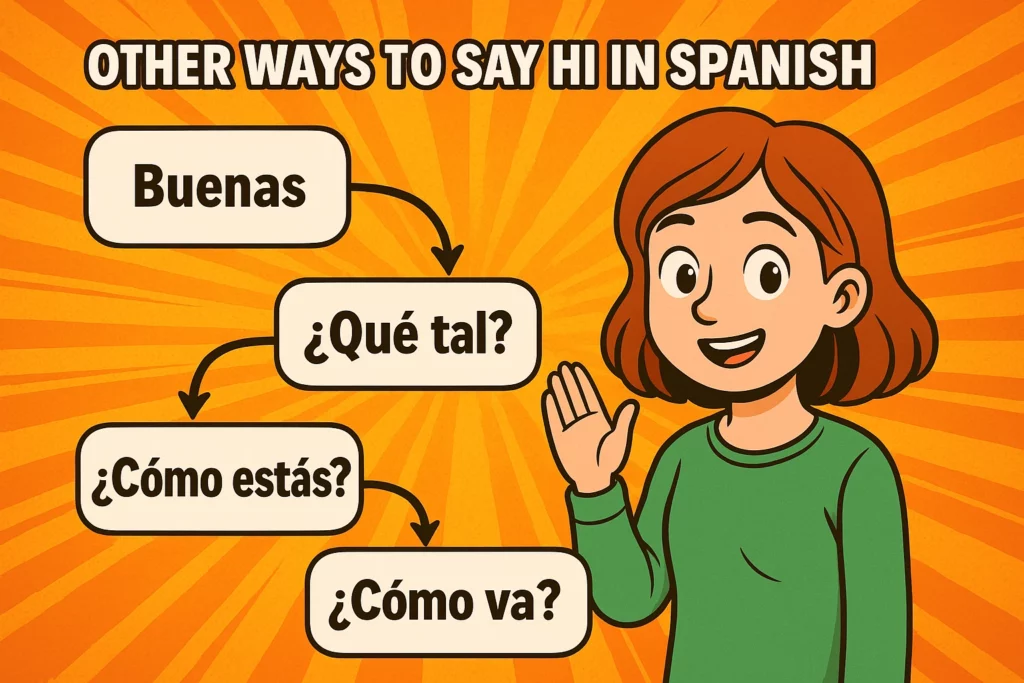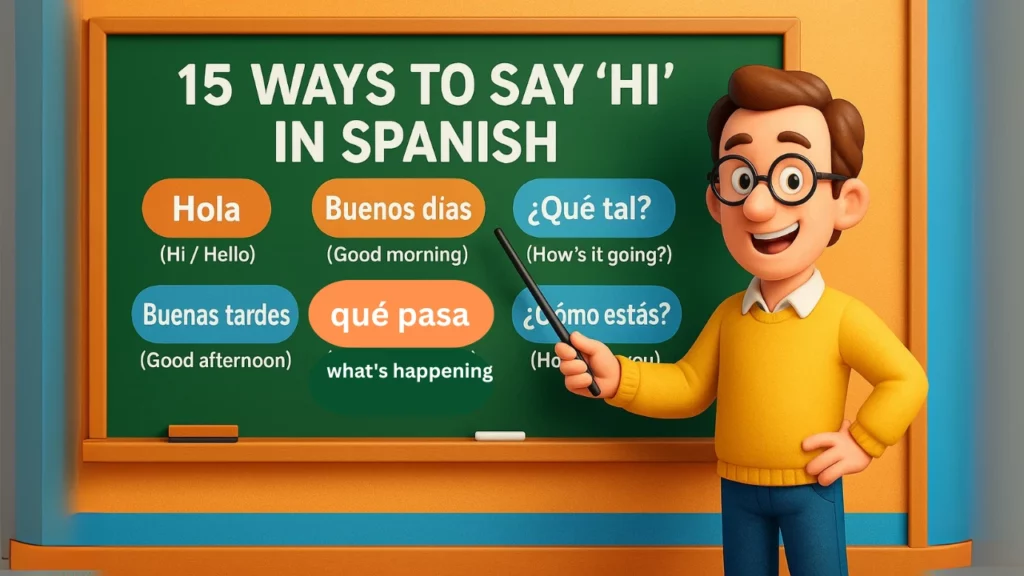
Hola, my dear students! Today, we’re going to start something truly exciting — discovering the different ways to say hi in Spanish that make your conversations feel real and natural.
Let me ask you something. Have you ever imagined walking through the streets of Madrid or chilling at a café in Mexico City? Suddenly someone smiles and says, “Hola”. You smile back, but… what else can you say?
Well, in Spanish, “Hola” (Hi) is just the beginning! There are so many creative, friendly, and natural expressions you can use when greeting someone. And today, I’m going to teach you 15 engaging and authentic Spanish greetings that will help you sound like a native speaker — not like a textbook!
Why is this important?
Because when you use real-life expressions, you instantly sound more confident and likable. Plus, you connect better with native speakers — whether you’re traveling, studying abroad, or chatting online.
So, are you ready? Let’s explore the world of Spanish greetings and become pros at saying “Hi” in every situation!
Why is Learning Different Greetings Important?
Now that you’ve heard the word “Hola” (Hi) probably a hundred times, you might wonder — why should I bother learning other ways to say it?
Well, here’s what I tell all my students:
If you want to sound like a native Spanish speaker, then you need to go beyond the basics.
Learning multiple ways to greet people in Spanish is not just about vocabulary. It’s about understanding the culture, showing respect, building trust, and choosing the right tone for the right situation.
Let me explain this with an example.
Imagine greeting your Spanish teacher with “¿Qué onda?” (What’s up?) — sounds cool, right? But it’s actually way too informal! That greeting is great for your friends, but not appropriate for formal conversations in Spanish.
So here’s why learning different greetings is important:
- It helps you speak Spanish more naturally, not like a robot.
- You’ll know how to say hi to friends, family, coworkers, or strangers — the right way.
- It shows that you care about the Spanish-speaking culture and greeting etiquette in Spanish-speaking countries.
- You’ll avoid common mistakes like mixing formal and informal expressions.
Trust me, native speakers love when learners use more than just “Hola.” It instantly makes you more likable and fluent.
So don’t just memorize — personalize!
15 Authentic Ways to Say ‘Hi’ in Spanish

Alright students, it’s time to get practical!
Below are some of the most common Spanish greetings you’ll hear in daily life — from schools to cafés, from Spain to South America.
Let’s start with the first 7:
1. Hola – (Hi / Hello)
This is the most basic and most recognized greeting in the Spanish language. It’s informal and friendly.
Example: Hola, ¿cómo estás?
(Hi, how are you?)
Use it with: friends, neighbors, classmates, even strangers. It’s the go-to word for saying hello in Spanish.
2. Buenos días – (Good morning)
Use it in the morning, usually before 12 PM.
Example: Buenos días, señora López.
(Good morning, Mrs. López.)
Perfect for formal Spanish greetings like office meetings or talking to elders.
3. Buenas tardes – (Good afternoon)
From around 12 PM to sunset, this is your go-to phrase.
Example: Buenas tardes, ¿todo bien?
(Good afternoon, all good?)
It’s one of the most polite Spanish greetings for daily use
4. Buenas noches – (Good evening / Good night)
Used in the evening or when saying goodbye at night.
Example: Buenas noches, nos vemos mañana.
(Good night, see you tomorrow.)
Use it to greet or say goodbye in the evening. Great for basic Spanish conversation at dinner or bedtime.
Suggestion: Easy 150+ French Adjectives With Phrases & Usage To Master In French.
5. ¿Qué tal? – (How’s it going?)
A casual, versatile greeting popular among all age groups.
Example: ¡Hola Pablo! ¿Qué tal?
(Hey Pablo! How’s it going?)
Excellent choice for Spanish conversation starters in informal settings.
6. ¿Cómo estás? – (How are you?)
Polite and friendly, works in almost all scenarios.
Example: ¿Cómo estás, Marta? Hace mucho que no te veo.
(How are you, Marta? It’s been a while since I saw you.)
A must-learn expression for greeting friends in Spanish and showing care.
7. ¿Qué onda? – (What’s up?)
Used mainly in Mexican Spanish, super casual and cool.
Example: ¿Qué onda, bro? ¿Listo para la fiesta?
(What’s up, bro? Ready for the party?)
Use this only with close friends — not in formal environments.
Related: Why Learning French is Important in Today’s Global Economy.
15 Authentic Ways to Say ‘Hi’ in Spanish

You’ve already learned the basics and some fun expressions. Now let’s go deeper and learn some greetings that native speakers use in different situations — from friendly street talk to polite introductions.
8. ¿Qué pasa? – (What’s happening? / What’s up?)
Another casual greeting similar to “What’s up?”, but more widely used across Spanish-speaking countries.
Example: ¡Eh! ¿Qué pasa, Luis?
(Hey! What’s happening, Luis?)
A classic phrase in Spanish greetings for daily use and common among both teenagers and adults.
9. Saludos – (Greetings)
This can be written or spoken and works in both casual and formal contexts.
Example: ¡Saludos desde Colombia!
(Greetings from Colombia!)
Great for basic Spanish conversation, travel blogs, postcards, or ending a conversation politely.
10. Buenas – (Short form of “buenos días/tardes/noches”)
Very casual. Often heard in Spain when people don’t want to say the full phrase.
Example: ¡Buenas! ¿Cómo va todo?
(Hi there! How’s everything going?)
Extremely useful in everyday Spanish conversation with strangers or in shops.
11. Encantado / Encantada – (Nice to meet you)
Use “Encantado” if you identify as male, “Encantada” if female.
Example: Hola, soy Carlos. Encantado.
(Hi, I’m Carlos. Nice to meet you.)
This is a polite way to greet in formal settings, like meetings and first-time encounters. It’s one of the best formal Spanish greetings.
12. Mucho gusto – (Pleased to meet you)
Gender-neutral and very polite.
Example: Mucho gusto. ¿Cómo se llama usted?
(Pleased to meet you. What’s your name?)
Commonly used in Spanish introductions and business or official contexts.
13. ¿Cómo te va? – (How’s it going for you?)
Friendly, slightly more reflective than “¿Cómo estás?”.
Example: ¡Hola Paula! ¿Cómo te va en tu nuevo trabajo?
(Hi Paula! How’s your new job going?)
This is great for Spanish conversation starters with acquaintances or colleagues.
14. Ey – (Hey)
Just like the English “Hey!” Very informal and usually used among young people.
Example: Ey, ¿vienes al cine esta noche?
(Hey, are you coming to the movies tonight?)
Perfect for informal greetings in Spanish, especially text messages or casual chats.
15. ¡Qué alegría verte! – (So nice to see you!)
Used when you’re genuinely happy to see someone again.
Example: ¡Qué alegría verte después de tanto tiempo!
(So nice to see you after such a long time!)
This adds emotion and warmth to greeting friends in Spanish.
Common Mistakes Students Make When Greeting in Spanish
Now that you’ve learned 15 authentic Spanish greetings, it’s time to make sure you’re using them correctly.
Because even the most confident learners sometimes make embarrassing mistakes — and we don’t want that, right?
Here are the top mistakes my students often make (and how to avoid them):
You May Also Like: Top 10 Apps To Master French In A Fun And Easy Way – Level Up Your Skills.
Mistake 1: Mixing Formal and Informal Greetings
Many students use casual phrases like ¿Qué onda? or Ey in professional settings.
Imagine saying “Ey” to your boss — not cool.
In formal settings, use greetings like Buenos días (Good morning) or Mucho gusto (Pleased to meet you) instead. These are the gold standard of formal Spanish greetings.
Mistake 2: Mispronouncing Simple Words
“Hola” is not “O-laa”
“Buenos días” is not “Bwenoz dee-as”
Practice the correct pronunciation daily. Use tools like YouTube or language apps. This is essential for mastering Spanish greetings pronunciation and sounding natural.
Mistake 3: Using “Hola” for Everything
Yes, it’s easy. But if all you say is “Hola,” you miss the chance to connect more deeply.
Spice it up! Use ¿Qué tal? (How’s it going?) or Buenas tardes (Good afternoon) depending on the time and person. This shows you understand the greeting etiquette in Spanish-speaking countries.
Mistake 4: Ignoring Cultural Context
In Spain, “Buenas” is common. In Latin America, “¿Qué onda?” is more popular. Using the wrong greeting in the wrong region may sound weird.
Learn region-specific phrases. This helps improve your basic Spanish conversation and cultural connection.
Mistake 5: Forgetting the Time of Day
Many students say Buenos días (Good morning) even in the afternoon or evening.
Use Buenas tardes (Good afternoon) after 12 PM and Buenas noches (Good evening/night) after sunset. Timing matters in everyday Spanish conversation.
Bonus Tip: Watch and Imitate Natives
The best way to fix mistakes? Watch native speakers. Listen. Repeat. Use what you hear.
That’s the secret to mastering common Spanish greetings the right way.
Quick Tips to Master Spanish Greetings Fast!
So, you’ve learned 15 powerful greetings, great job!
But how do you actually remember them? How do you make sure they roll off your tongue naturally like a native?
Here are my quick and effective tips to master Spanish greetings fast:
Related: Mastering French ‘IR’ Verbs: A Guide To Conjugation And Usage.
1. Practice Out Loud Every Day
Don’t just read — speak! Say “Hola,” “¿Qué tal?” or “Buenas tardes” out loud, even to yourself in the mirror. Repetition is the key to how to learn Spanish fast and build speaking confidence.
2. Use Flashcards with Audio
Create flashcards with both Spanish greetings and their English translations. Make sure the audio is correct and native-like. It helps train your Spanish listening and speaking skills.
3. Watch Spanish TV Shows or YouTube Videos
Real-life dialogue is the best teacher. Pay attention to how native speakers greet each other in different contexts. This is how you improve Spanish greetings for beginners and learn Spanish naturally.
4. Practice with Native Speakers
Join a language exchange group or use apps like HelloTalk, Tandem, or Speaky. You’ll get real feedback and learn cultural context too — both important for speaking Spanish fluently.
5. Set One Greeting Goal Per Day
Each morning, pick a greeting to focus on. For example, Monday = Buenos días, Tuesday = ¿Qué onda?, Wednesday = Encantado. Use it throughout the day — this is a fun trick to boost your daily Spanish expressions.
6. Use Your Greetings in Real Conversations
Next time you meet someone who speaks Spanish, don’t hesitate. Start with a warm “Hola, ¿cómo estás?”. Using the phrases is the only way to make them stick!
Remember: Language is a muscle. The more you use it, the stronger it gets.
FAQ’s About Spanish Greetings
Q1: What is the most formal way to say hello in Spanish?
The most formal greeting is “Buenos días” (Good morning). It’s commonly used in professional settings like offices, meetings, and with elders. You can also say “Mucho gusto” (Pleased to meet you) when introducing yourself. These are the go-to phrases for formal Spanish greetings.
Q2: Can I use “Hola” in a professional environment?
The most formal greeting is “Buenos días” (Good morning). It’s commonly used in professional settings like offices, meetings, and with elders. You can also say “Mucho gusto” (Pleased to meet you) when introducing yourself. These are the go-to phrases for formal Spanish greetings.
Q3: What is the difference between “¿Qué tal?” and “¿Cómo estás?”?
Both mean “How are you?” but there’s a subtle difference.
- ¿Qué tal? (How’s it going?) is more casual and conversational.
- Understanding these differences helps improve your basic Spanish conversation skills.
- ¿Cómo estás? (How are you?) shows genuine concern about someone’s well-being.
Q4: Which Spanish greeting should I use at night?
At night or when saying goodbye in the evening, use “Buenas noches” (Good evening / Good night). It works both as a greeting and a polite farewell — a key part of daily Spanish expressions.
Q5: Are greetings different in Spain and Latin America?
Yes, some expressions are more regional.
- In Mexico: “¿Qué onda?” is widely used among friends.
- Learning regional usage is crucial to speak Spanish naturally and avoid sounding out of place.
- In Spain: people often use “Buenas” as a short form.
Q6: How can I remember all these Spanish greetings easily?
Use flashcards, practice aloud, and set one greeting per day. You can also repeat them in front of a mirror or while watching Spanish shows. This is a great method if you’re wondering how to learn Spanish fast.
Conclusion
Congratulations, my amazing learners! You’ve now explored 15 powerful and authentic ways to say hi in Spanish, along with real-life examples, pronunciation tips, and regional insights.
But here’s the thing: memorizing greetings is only the first step in learning Spanish. The real magic happens when you start using them in everyday Spanish conversations. So don’t hesitate! Greet your friends, teachers, or language partners with confidence.



